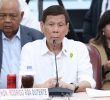According to regulations, male and female inmates are to be held in separate facilities and, in national prisons, overseen by guards of the same sex; however, there were anecdotal reports that these regulations were not uniformly enforced. In provincial and municipal prisons, male guards sometimes supervised female prisoners directly or indirectly. Although prison authorities attempted to segregate children, in some instances they were held in facilities not fully segregated from adult male inmates (see section 5). Only 223 out of 1,100 jails managed by the BJMP and PNP had separate cells for minors, while 345 jails had separate cells for females. During the year the BJMP established two detention centers exclusively for women. Approximately 1,200 women inmates were transferred to these new facilities, located in Metro Manila and in Cebu City. More than 300 minor inmates were transferred to three youth centers in compliance with the new law on juvenile justice. In Bureau of Immigration detention facilities, male and female inmates are segregated by sex, but male guards oversaw both sexes.
International monitoring groups, including the International Committee of the Red Cross, were allowed free access to jails and prisons.
d. Arbitrary Arrest or Detention
The law requires a judicial determination of probable cause before issuance of an arrest warrant and prohibits holding prisoners incommunicado or in secret places of detention; however, in a number of cases, police arrested and detained citizens arbitrarily. Through December, the TFDP documented 35 cases of illegal arrest and detention involving 114 victims.
Role of the Police and Security Apparatus
The Department of National Defense directs the AFP, which shares responsibility for counterterrorism and counterinsurgency operations with the PNP. The Department of Interior and Local Government directs the PNP, which is responsible for enforcement of law and order and urban counterterrorism; however, governors, mayors, and other local officials have considerable influence. The 115,000 member PNP has deep-rooted institutional deficiencies and suffered from a widely held and accurate public perception that it was corrupt. The PNP’s Internal Affairs Service remained largely ineffective. Members of the PNP were regularly accused of torture, of soliciting bribes, and of other illegal acts. Efforts were underway to reform the institution in part to counter a widespread impression of official impunity. From January to November, the PNP dismissed 89 policemen. Of the 2,859 administrative cases filed against PNP officers and personnel, 1,398 were resolved, 944 remained under preliminary investigation, 391 underwent summary hearings, and the remaining 126 were filed with the People’s Law Enforcement Board, a body composed of local government officials and NGO representatives that receives complaints filed against members of the PNP in the regions. In 2005 the PNP initiated a Transformation Program aimed at systematic institutional reform.
Arrest and Detention
Detainees have the right to a judicial review of the legality of their detention and, except for offenses punishable by a life sentence, the right to bail; however, only 6.5 percent of detainees were able to post bail. Authorities are required to file charges within 12 to 36 hours of arrests made without warrants, with the time given to file charges increasing with the seriousness of the crime. Lengthy pretrial detention remained a problem (see section 1.e.). In 2005 the courts released 67 detainees who had been held in jail for periods equal to or longer than the maximum prison terms they would have served if convicted. Through November only two detainees were released under this circumstance.
The NPA, as well as some Islamic separatist groups, were responsible for a number of arbitrary detentions, often in connection with informal courts set up to try military personnel, police, local politicians, and other persons for “crimes against the people” (see section 1.e.).
e. Denial of Fair Public Trial
The law provides for an independent judiciary; however, the judicial system suffered from corruption and inefficiency. Personal ties and sometimes venality resulted in impunity for some wealthy and influential offenders and contributed to widespread skepticism that the judicial process could ensure due process and equal justice. The Supreme Court continued efforts to ensure speedier trials and to sanction judicial malfeasance and was in the midst of a five-year program to increase judicial branch efficiency and raise public confidence in the judiciary.
Extrajudicial Killings, Terrorism









